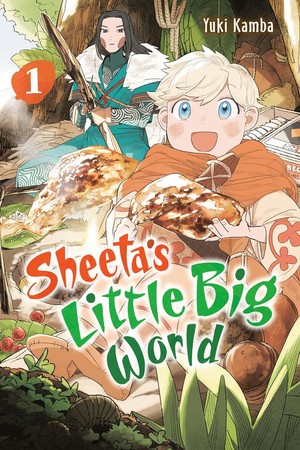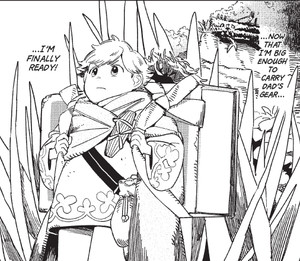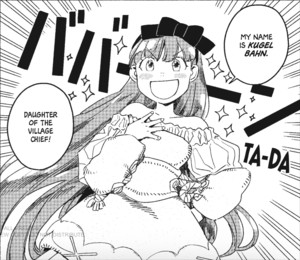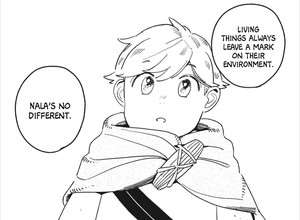The Fall 2025 Manga Guide
Sheeta's Little Big World
What's It About?

Sheeta and Nala live happily inside a hollowed-out log with their fellow "littlefolk," who stand no taller than a blade of grass. When Nala runs off one day to investigate a mysterious smoke signal, Sheeta must summon all his courage and wits as he sets off in pursuit. Rats, ants, weasels, giants... The wide world is full of dangers, but the plucky Sheeta will stop at nothing to find his friend.
Sheeta's Little Big World has art and story by Yuki Kamba. English translation is done by Andres Oliver, and lettering by Lys Blakeslee. Published by Kodansha Comics (September 23, 2025). Rated T.
Is It Worth Reading?
Rebecca Silverman
Rating:

Sheeta's Little Big World seems to exist as an answer to the question, “What if Mary Norton's The Borrowers Afield was much scarier and more brutal?” I'm not sure that question needed asking or answering, but it is nonetheless difficult not to make comparisons with Norton's classic mid-century stories about a family of tiny people. Unlike Norton's Borrowers, however, Yuki Kamba's Littlefolk don't live alongside humans. In fact, there are some questions as to whether or not the existence of humans is widely known. Sheeta's father left him a box of “magic wands” (matches), but the sight of human footprints near a distant tree doesn't seem to speak to Sheeta or his adult companion, Izuna. There's one off-hand comment about “giants,” but no clear indication that they believe giants to be real. And why would there be? The Littlefolk have enough troubles existing alongside nature, surrounded by predators of all shapes and sizes.
That's what makes Sheeta's journey so perilous. Five years ago, he was left by his father in the stump village (built inside a hollow log), making him the only person to have really gone outside the safety of the town. His best friend and adoptive brother, Nala, burns to leave that safety, and it's his disappearance that spurs Sheeta's own departure, even though there's no real hope that Nala has survived and at least one hint that he hasn't. Rats, weasels, ants, and frogs are the predators introduced in this volume, and all of them are deadly in their own ways, and that's just the list of living threats to Sheeta – the weather and simple things like mud all also pose danger to a boy shorter than a blade of grass. And even towns aren't truly safe: he meets Izuna because the man is looking to avenge the destruction of his village, and later, Sheeta and Izuna witness the destruction of another town by a swarm of ants. Littlefolk live in a constant state of fear.
What this basically means is that if you're looking for a cute and fluffy fantasy manga, this is emphatically not it. The Littlefolk are drawn to be adorable, but their story is not; this is fantasy with teeth and a hefty dose of existential crisis. The art is wonderful, though, and care has been taken to make it look as real as possible with the plant and animal life. The translation is highly readable, too, even if I wish that someone had taken it upon themselves to change the name Kugel to anything else. Yes, Kugel's mom also has a food name, but for whatever reason, I really struggle with “noodle pudding” as a moniker.
Kevin Cormack
Rating:

I would suggest that Sheeta's Little Big World would be like “what if Mary Norton's The Borrowers, but by Studio Ghibli,” but then the movie The Secret World of Arrietty already exists. However, that's not directed by Hayao Miyazaki. Sheeta's Little Big World is more like if the Miyazaki of Nausicaa or Princess Mononoke made his own take on The Borrowers Afield. With a deceptively simple, organic art style (though perhaps not quite as striking or accomplished as Miyazaki's), diminutive hero Sheeta's journey through the towering forest is full of extreme danger. As a tiny person not much taller than a matchbox, even small birds and mammals pose a significant threat to his life. Leaving the safety of his hollowed-out log home, he sets out in search of his missing friend.
On the way, Sheeta meets other small people trying to survive in their own ways, battling against weasels and armies of ants. Izuna is a samurai-like warrior searching for Sheeta's mysterious (criminal?) father, who abandoned him years previously. He reluctantly teaches the naive, childlike Sheeta to survive in the dangerous outside world. Princess Kugel is a slightly older girl, headstrong and stubborn, whose village is embattled against tireless invaders. She reminds me a lot of Steamboy's Scarlett.
This is the first of three volumes and ends on a slightly cruel cliffhanger. It's a really fun fantasy series with some compelling underlying mysteries about the world and the characters' origins, plus the setting is intelligently realized. For example, Kugel's village economy and lifestyle hinge on the free availability of sugary maple sap, so it's no wonder that ants relentlessly attack them. Fighting off one ant is manageable for a little person, but not a group of one hundred, led by pheromones to their target. It's this kind of thoughtful world-building that makes me very intrigued to see where Sheeta's Little Big World goes next.
Bolts
Rating:

I've always been fascinated by stories revolving around little people. You can get very creative and inventive with scenarios where characters make use of everyday items that we take for granted. A simple splinter can be a sphere, but likewise, an unassuming animal could turn into a ferocious beast. Sheeta's Little Big World, I think, gets down a lot of the basics of this type of story, showing just how dangerous a lot of these creatures can be. It also helps that the story is from the perspective of children who are even smaller and need potentially even more inventiveness with these types of dangerous situations. When you're that small, everything wants to kill you, and there is a real sense of danger here.
The character's fears are completely justified. There is a hope that our protagonist is able to find his friends and his father because the fear that they can't survive in this dangerous world is the driving force of the narrative. The setup is very simple, and I wish it did take advantage of the setting even more, but this is a good introduction to a larger world that I want to know more about. The story even brings up things I rarely think about, like a small person's relationship with insects and how that can be dangerous. Even if a person is larger than an ant, it might not be by much, and being swarmed by large numbers can be just as dangerous as taking on a giant weasel. There are a lot of allegories for coming of age here, and how that relates back to nature. Honestly, this reminds me of a lot of older stories that I grew up with.
I'm not the biggest fan of the art style or overall presentation of the manga, as I do think it holds things back. The character designs have an endearing and almost childlike quality to them, which fits when you consider the fact that this whole story is from the perspective of a child. That does contrast well with the more realistic elements and textures that the author applies to things like the backgrounds and animals. It really does feel like a whimsical person is trapped in a more realistic and dangerous world. The problem is that sometimes the artist goes a little bit overboard with the textures and details to the point where things end up looking very messy. Actions aren't clearly communicated as I would like them to be, which makes it difficult to get out of a lot of those stressful situations. While it doesn't go as far as I would like it to be, this does set itself up to be a solid adventure that I think people of multiple ages should be able to enjoy.
The views and opinions expressed in this article are solely those of the author(s) and do not necessarily represent the views of Anime News Network, its employees, owners, or sponsors.
discuss this in the forum (22 posts) |
this article has been modified since it was originally posted; see change history
back to The Fall 2025 Manga Guide
Seasonal homepage / archives